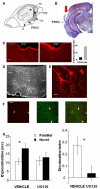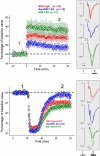ERK pathway activation bidirectionally affects visual recognition memory and synaptic plasticity in the perirhinal cortex
- PMID: 22232579
- PMCID: PMC3246765
- DOI: 10.3389/fnbeh.2011.00084
ERK pathway activation bidirectionally affects visual recognition memory and synaptic plasticity in the perirhinal cortex
Abstract
ERK 1,2 pathway mediates experience-dependent gene transcription in neurons and several studies have identified its pivotal role in experience-dependent synaptic plasticity and in forms of long term memory involving hippocampus, amygdala, or striatum. The perirhinal cortex (PRHC) plays an essential role in familiarity-based object recognition memory. It is still unknown whether ERK activation in PRHC is necessary for recognition memory consolidation. Most important, it is unknown whether by modulating the gain of the ERK pathway it is possible to bidirectionally affect visual recognition memory and PRHC synaptic plasticity. We have first pharmacologically blocked ERK activation in the PRHC of adult mice and found that this was sufficient to impair long term recognition memory in a familiarity-based task, the object recognition task (ORT). We have then tested performance in the ORT in Ras-GRF1 knock-out (KO) mice, which exhibit a reduced activation of ERK by neuronal activity, and in ERK1 KO mice, which have an increased activation of ERK2 and exhibit enhanced striatal plasticity and striatal mediated memory. We found that Ras-GRF1 KO mice have normal short term memory but display a long term memory deficit; memory reconsolidation is also impaired. On the contrary, ERK1 KO mice exhibit a better performance than WT mice at 72 h retention interval, suggesting a longer lasting recognition memory. In parallel with behavioral data, LTD was strongly reduced and LTP was significantly smaller in PRHC slices from Ras-GRF1 KO than in WT mice while enhanced LTP and LTD were found in PRHC slices from ERK1 KO mice.
Keywords: ERK1,2; perirhinal cortex; recognition memory; synaptic plasticity.
Figures





Similar articles
-
Derangement of Ras-guanine nucleotide-releasing factor 1 (Ras-GRF1) and extracellular signal-regulated kinase (ERK) dependent striatal plasticity in L-DOPA-induced dyskinesia.Biol Psychiatry. 2015 Jan 15;77(2):106-15. doi: 10.1016/j.biopsych.2014.04.002. Epub 2014 Apr 12. Biol Psychiatry. 2015. PMID: 24844602
-
Neuron-Derived Estrogen Regulates Synaptic Plasticity and Memory.J Neurosci. 2019 Apr 10;39(15):2792-2809. doi: 10.1523/JNEUROSCI.1970-18.2019. Epub 2019 Feb 6. J Neurosci. 2019. PMID: 30728170 Free PMC article.
-
Activation of mitogen-activated protein kinase/extracellular signal-regulated kinase in hippocampal circuitry is required for consolidation and reconsolidation of recognition memory.J Neurosci. 2003 Jun 15;23(12):5354-60. doi: 10.1523/JNEUROSCI.23-12-05354.2003. J Neurosci. 2003. PMID: 12832561 Free PMC article.
-
Impaired cerebellar plasticity and eye-blink conditioning in calpain-1 knock-out mice.Neurobiol Learn Mem. 2020 Apr;170:106995. doi: 10.1016/j.nlm.2019.02.005. Epub 2019 Feb 5. Neurobiol Learn Mem. 2020. PMID: 30735788 Review.
-
Mechanisms of synaptic plasticity and recognition memory in the perirhinal cortex.Prog Mol Biol Transl Sci. 2014;122:193-209. doi: 10.1016/B978-0-12-420170-5.00007-6. Prog Mol Biol Transl Sci. 2014. PMID: 24484702 Review.
Cited by
-
Extracellular signal-regulated kinase regulates microglial immune responses in Alzheimer's disease.J Neurosci Res. 2021 Jun;99(6):1704-1721. doi: 10.1002/jnr.24829. Epub 2021 Mar 17. J Neurosci Res. 2021. PMID: 33729626 Free PMC article.
-
Contributions of extracellular-signal regulated kinase 1/2 activity to the memory trace.Front Mol Neurosci. 2022 Oct 5;15:988790. doi: 10.3389/fnmol.2022.988790. eCollection 2022. Front Mol Neurosci. 2022. PMID: 36277495 Free PMC article. Review.
-
Upregulation of RasGRF1 ameliorates spatial cognitive dysfunction in mice after chronic cerebral hypoperfusion.Aging (Albany NY). 2023 Apr 12;15(8):2999-3020. doi: 10.18632/aging.204654. Epub 2023 Apr 12. Aging (Albany NY). 2023. PMID: 37053022 Free PMC article.
-
Mapk/Erk activation in an animal model of social deficits shows a possible link to autism.Mol Autism. 2014 Dec 22;5:57. doi: 10.1186/2040-2392-5-57. eCollection 2014. Mol Autism. 2014. PMID: 25874073 Free PMC article.
-
Mice Lacking Ras-GRF1 Show Contextual Fear Conditioning but not Spatial Memory Impairments: Convergent Evidence from Two Independently Generated Mouse Mutant Lines.Front Behav Neurosci. 2011 Dec 6;5:78. doi: 10.3389/fnbeh.2011.00078. eCollection 2011. Front Behav Neurosci. 2011. PMID: 22164138 Free PMC article.
References
LinkOut - more resources
Full Text Sources
Molecular Biology Databases
Research Materials
Miscellaneous

